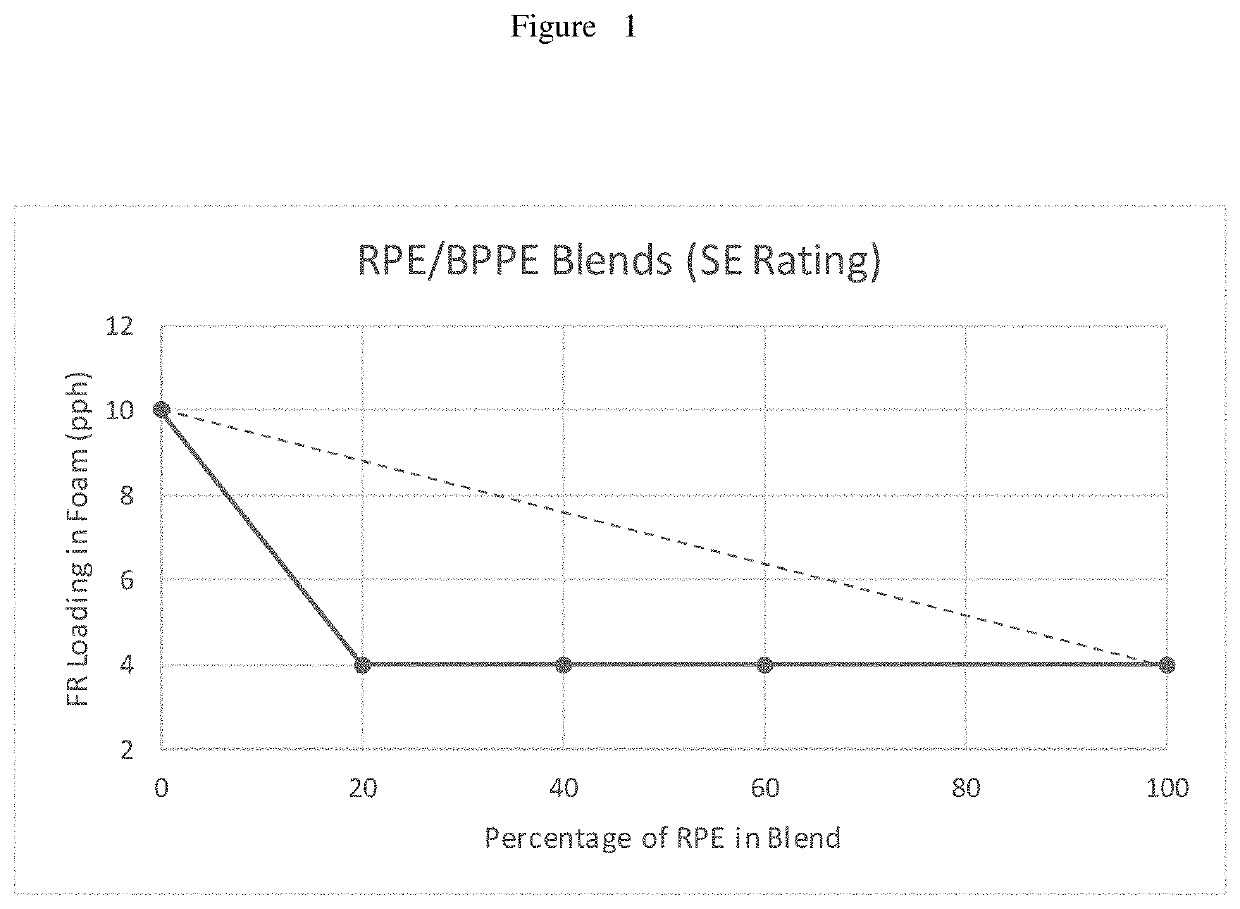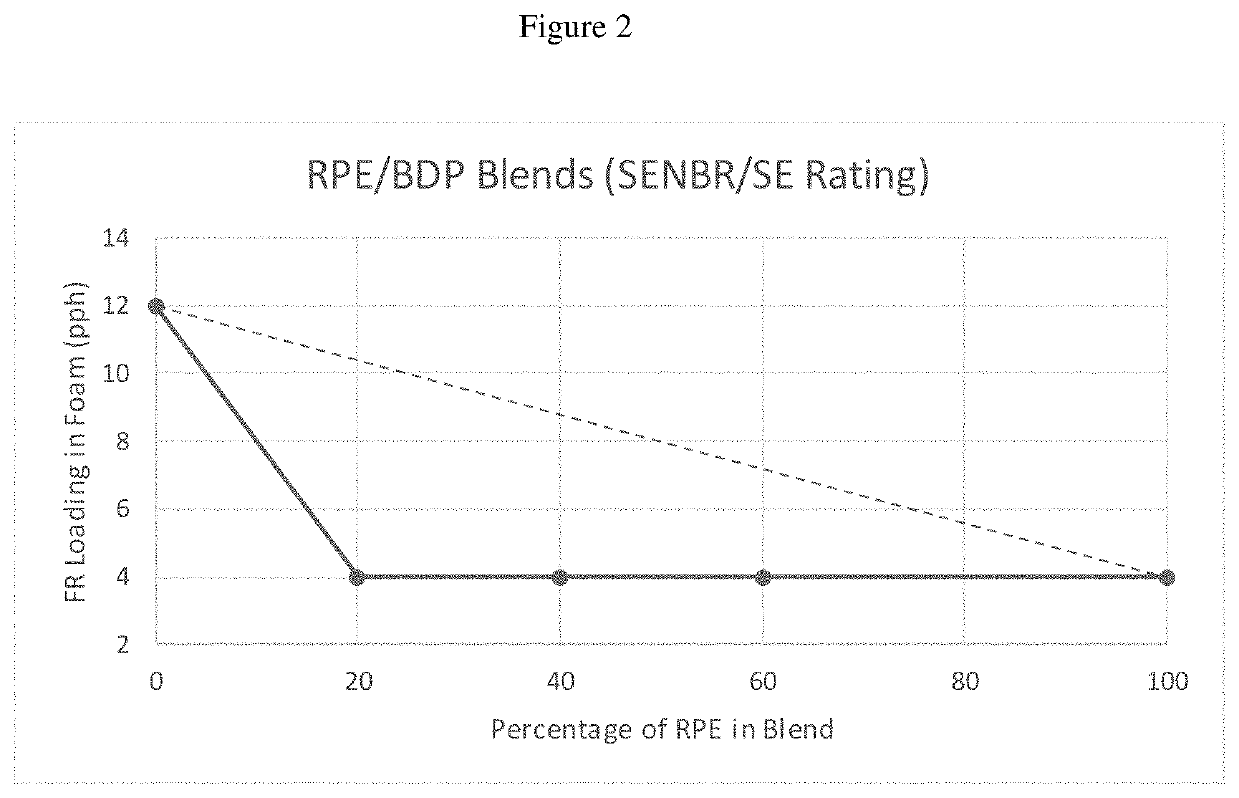Reactive flame retardant blends for flexible polyurethane foam
a flame retardant and polyurethane foam technology, applied in the field of reactive flame retardant blends for flexible polyurethane foam, can solve the problems of poor foam physical properties and loss of foam's ability to recover, and achieve the effects of good hydrolytic and thermal stability, high phosphorus content, and good compatibility with diol and/or polyol components
- Summary
- Abstract
- Description
- Claims
- Application Information
AI Technical Summary
Benefits of technology
Problems solved by technology
Method used
Image
Examples
preparation example 1
[0128]
[0129]A 2-liter, jacketed, hastelloy reactor equipped with a mechanical stirrer, oil heater and positive displacement laboratory pump was charged with diethyl phosphinic acid (779 g, 6.38 mol) and sealed. The reactor was heated to an internal temperature of 45° C. Propylene oxide (743 g, 12.77 mol) was added to the reactor via the pump over two hours with the temperature being maintained below 65° C. Subsequently the reactor internal temperature was increased to 90° C. and maintained there for three hours. The excess propylene oxide was evaporated and the residue was distilled under vacuum (300-500 mTorr) using a wiped film evaporator at a jacket temperature of 125° C. The target fraction was collected as a clear, colorless liquid. The yield was 90% with respect to the starting diethyl phosphinic acid. The product was a mixture of two isomers of hydroxyl-functional esters of diethyl phosphinic acid, 31P NMR (acetic acid-d4, ppm): 66.8-67.7; and had an acid # of 0.4 mg KOH / g an...
preparation example 2
[0130]
[0131]A 1-liter flask, with a heating mantle, mechanical stirrer, reflux condenser, dip tube, j-chem controller and thermocouple, and caustic scrubber was charged with diethyl phosphinic acid (469 g, 3.84 mol). The flask was heated to 80° C. and ethylene oxide from a pressurized cylinder was charged into the reactor through the dip tube over five hours. Final molar ratio of ethylene oxide to diethyl phosphinic acid was 1.33. The reaction mixture was kept at 80° C. for additional three hours. Further nitrogen was passed through the dip tube to remove the excess ethylene oxide. A batch distillation of the residue was done at 150° C. and 200 mTorr resulting in a clear liquid (400 g). The product was 2-hydroxyethyl ester of diethyl phosphinic acid, 31P NMR (CDCl3, ppm): 79; and had an acid # of 0.4 mg KOH / g.
application example 3
[0132]MVSS 302 Test: This test is a horizontal flame test that is used as a guideline for automobile manufactures. The sample size was 14″×4″×½″. There is a line 1¼″ from the ignition point. A flame was ignited for fifteen seconds. The ignition source was then turned off and the sample was rated. A “DNI” rating indicates that the sample did not support combustion (“did not ignite”). A rating of “SE” indicates that the sample ignited but did not burn to the timing zone, which is a point starting from the 1½″ mark to the 3½″ line. A rating of “SENBR” indicates that the sample burned past the 1½″ line but was extinguished before the 3½″ mark. A rating of “SE / B” indicates that a sample burned past the 3½″ mark but was extinguished before the endpoint. An inch per minute rate was then calculated. The burn rate indicates that a sample burned passed the 3½″ mark. An indication of a burn rate or an SE / B rating that was higher than 4.0 in / min indicates failure in accordance with this test. F...
PUM
| Property | Measurement | Unit |
|---|---|---|
| temperature | aaaaa | aaaaa |
| temperature | aaaaa | aaaaa |
| temperature | aaaaa | aaaaa |
Abstract
Description
Claims
Application Information
 Login to View More
Login to View More - R&D
- Intellectual Property
- Life Sciences
- Materials
- Tech Scout
- Unparalleled Data Quality
- Higher Quality Content
- 60% Fewer Hallucinations
Browse by: Latest US Patents, China's latest patents, Technical Efficacy Thesaurus, Application Domain, Technology Topic, Popular Technical Reports.
© 2025 PatSnap. All rights reserved.Legal|Privacy policy|Modern Slavery Act Transparency Statement|Sitemap|About US| Contact US: help@patsnap.com



